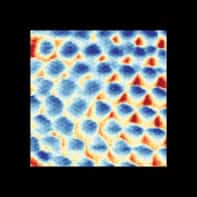
The first Bose–Einstein condensate (BEC) to be cooled using just lasers has been made by a team in Austria. The process is much simpler, faster and more efficient than previous methods, which involve an extra stage of evaporative cooling. The scientists hope that their breakthrough will lead to more widespread use of BECs in various areas of physics, including atomic clocks and atom lasers.
A BEC is a dense cluster of atoms cooled so close to absolute zero that all of the atoms are in a single quantum state and can therefore be described by the same wavefunction. The first pure BEC was made in 1995 by Eric Cornell and Carl Wieman at JILA in Boulder, Colorado. Since then, BECs have been used – or proposed for use – to create atom circuits, rotation sensors, atom lasers and other novel devices.
Making a BEC traditionally involves the two-step cooling of a cloud of atoms contained in a magnetic trap. The first step is laser cooling. It involves choosing an electronic transition of the atom to be cooled and irradiating the atom cloud with laser light of an energy slightly below this transition. For the most energetic atoms trying to climb out of the trap, the laser light is blue-shifted to the transition frequency. These atoms can therefore absorb a photon, which pushes them back. It also promotes the atoms into the excited state. When the atom decays back to the ground state, it emits a photon of a higher energy than the one it absorbed. The overall effect is that the gas cools and becomes denser.
Shifting heat around
As the density rises, however, a photon emitted by one atom becomes more likely to be absorbed by another atom. Instead of cooling the gas, this simply moves heat around. Moreover, the atom that absorbs the photon recoils in the opposite direction from the atom that emits it, thus creating a repulsive force between the atoms that stops the gas reaching a sufficiently high density for a BEC.
Researchers then have to resort to evaporative cooling, in which the higher-energy atoms are allowed to leave the trap. The remaining lower-energy atoms comprise a colder ensemble that reaches the required nanokelvin temperatures for a BEC to form. Evaporative cooling, however, is time consuming and about 99% of the atoms are lost during the process.
Achieving all-laser cooling of a BEC has been an important goal for physicists because it would allow condensates to be used in a wider range of applications. Now, Florian Schreck and colleagues at the Institute for Quantum Optics and Quantum Information in Innsbruck, Austria, have used a neat trick to achieve this. Within the initial, shallow, magnetic trap used to create their BEC, the researchers create a small “dimple” in which the trapping potential is higher. Atoms naturally have a higher density in this region and under normal circumstances the higher pressure would result in a higher temperature. A second “transparency” laser beam is focused on the dimple to increase the energy of the cooling transition in that region. This shift makes the dimple transparent to the cooling laser while still allowing the surrounding gas cloud to absorb cooling photons. Heat flows freely from the dimple trap to the laser-cooled gas cloud and this allows the dimple to become dense while staying cold. Ultimately, a BEC forms in the dimple.
“Excellent” work
Jun Ye of JILA describes the research as “excellent”. “Every aspect of their work, if you put it on individual terms, has been investigated in a different context,” he explains. “What the researchaers have done is to combine all these aspects together to achieve something that nobody has ever done before.” Ye, who works on atomic clocks, thinks Schreck’s results could be applied to that field. “We are already thinking about following their approach and exploring the use of condensates in atomic clocks,” he says, something that has been “unrealistic” using traditional methods for producing the condensates.
Schreck, meanwhile, is moving to the University of Amsterdam, where he hopes to produce a continuous atom laser. Atom lasers use the coherent atoms of a BEC to create a beam. The wavelength of the atoms is much smaller than optical photons, which would make such lasers useful for ultra-sensitive holography and inteferometry. Today, atom lasers only work for a short time before the condensate has to be refilled. The cooling system devised by Schreck’s group, however, can produce a continuous condensate, provided the trap is kept supplied with atoms. Schreck says this could lead to “a machine that you switch on once and at the other end there is a beam of condensed atoms coming out”.
The research is published in Physical Review Letters.



